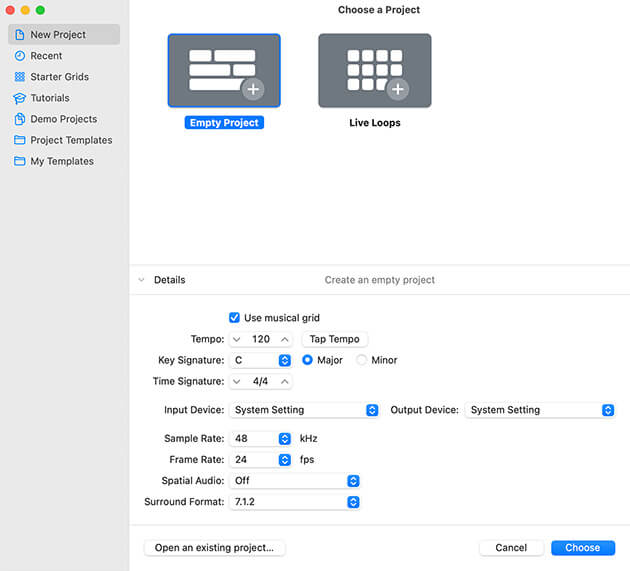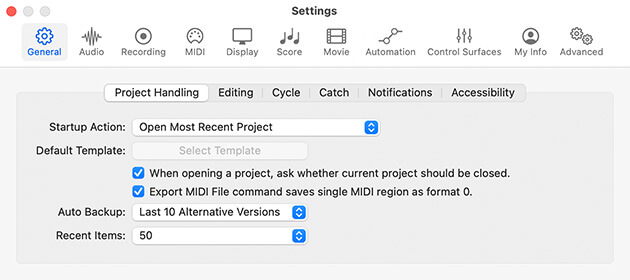 ©Yakobchuk / Adobe Stock
©Yakobchuk / Adobe StockProjects are flexible. When disk space is a concern, for example, you can save only the assets you want to keep. You can create project templates to speed up your workflow and set up Logic Pro exactly how you want to work. Each project contains global settings of the entire project as well as different snapshots of the project, such as different arrangements, mixes, or treatments. For example, you can create an alternate version of your project if the producer calls for a version without a vocal (for when the performer needs to sing live on TV to a backing track).
Starting your project
A project is the file type that you work with in Logic Pro. The file extension of a Logic Pro project is .logicx. The project file contains MIDI events, parameter settings, and information about the audio and video in your project.To get the big picture of your project and how it relates to Logic Pro, the hierarchy goes like this:
Project → Tracks → Regions → Events
Your project contains tracks. Your tracks contain regions. Your regions contain events. The File menu is where you do most of your project-level work.
To start an empty default Logic Pro project, choose File → New or press Shift+Command+N. A New Tracks dialog window opens, as shown in the figure below. At the top of the screen, choose the type of track you want to begin working with and click Create.
 ©Logic Pro
©Logic ProThe New Tracks dialog is where you choose your first track.
A more advanced and customized way to start a new project is to choose File → New from Template (Command+N). The Project Chooser window opens, as shown in the figure below. You can select a premade project template, a recent project, or your own customized project template. Click the Details disclosure triangle (at the bottom left) to display even more options for your new project, such as the tempo, time and key signatures, and audio input and output.
 ©Logic Pro
©Logic ProChoose customizable project templates here.
You can change any project option, but you should stick to a single sample rate. The default sample rate, 44.1 kHz, is the standard rate for an audio CD. If your goal is to use your audio in a video project, consider using a 48 kHz sample rate, which is the video standard. Using higher sample rates depends on your hardware capabilities and project needs.
After you start your project, you’re ready to begin recording, arranging, editing, and mixing. It’s a dream come true.
Choose a custom startup action to tell Logic Pro what to do when you launch it. If you’re the prolific type, you can create a new project every time you launch the app. If you, like me, are a mere mortal, you might want to open the most recent project on startup. Choose Logic Pro → Settings → General and select the Project Handling tab, as shown in the figure below. Then select your startup action.
 ©Logic Pro
©Logic ProCustomize your startup action.
Opening a project
You can open a project in several ways. You can double-click a project file in Finder, which will launch Logic Pro and open the project. If another project is open, Logic Pro will ask if you want to close the project. More than one project can be open simultaneously, so closing the current project is unnecessary. To switch between open projects, choose Window on the main menu and then select the project in the list at the bottom of the menu.You can open a project also from the File menu. Choose File → Open or press Command+O, and a dialog will open, allowing you to navigate to the location of your project in Finder. Choose File → Open Recent instead to see a list of your recent projects.
Logic Pro can also open MIDI files, AAF files (Advanced Authoring Format files used by digital audio workstations such as Pro Tools), XML files (used by Final Cut Pro), and GarageBand projects. It can also open projects created with earlier versions of Logic Pro.
If this is your first time launching Logic Pro, you might want to explore a demo project by a popular artist. Choose File → New from Template (Command+N) and select Demo Projects in the Project Chooser sidebar. Then select a demo project and press Choose.
Saving a project
When you create your project, it is autosaved in the Logic folder under the temporary name Untitled.logicx. (You can get to the Logic folder in Finder by navigating to Users → USERNAME → Music → Logic.)To save your project manually, choose File → Save. In the Save dialog that appears, name your project and choose a location or keep the default location, which is the Logic folder. You can choose to organize your project as a package or a folder. A package saves your project as a single file that includes all project assets. A folder saves the project file and saves its assets in subfolders.
You can also choose to copy specific file types into your project. It’s a good idea to copy your audio files into the project, but you might not want to copy samples due to their potentially large file size. The benefit to saving a project without assets is that you conserve hard drive space. The downside is that it can be easy to mistakenly delete assets that the project depends on. Hard drive space is inexpensive, so it makes sense to include all assets in your project folder. By doing so, organizing, moving, and archiving projects will be easier.
I find saving projects as packages is the simplest approach. You can view the contents of packages (all package file types, including Pages, Keynote, and Numbers files) by Ctrl-clicking the package in Finder and choosing Show Package Contents. All your audio files and assets will be in the Finder window that opens.
If you want to save the project with a different name or in a different location, choose Save As on the File menu. If you want to create a copy of the project, choose Save a Copy As on the File menu.Closing a project
When you’re ready to close your project, choose File → Close Project. If you’ve made any changes since you last saved your project, Logic Pro asks if you want to save the project. If you don’t want to keep those changes, select Don’t Save from the Save dialog.Don’t confuse the Close Project command with the Close command. Both are on the File menu. The Close command simply closes the currently focused window. However, if your project has only one window open, which is often the case, using the Close command will also close your current project.
Naming and renaming a project
It’s a good idea to have a naming convention and stick with it. When I’m saving a project that doesn’t yet have a title, my file-naming convention is to use the date, key signature, harmonic mode, and tempo, followed by any other useful descriptors such as the musical genre, song section, and version numbers. For example:2022-06-03 Cmin Dorian 120bpm EDM verse 01
Naming your file this way enables you to match projects based on mode and tempo. If you eventually come up with a title for your project, use the Save As command (described earlier) or just rename the project file in Finder. Or you can use the Rename function by choosing File → Project Management → Rename.
Augmenting your project
Projects are so basic to your workflow that you may take them for granted after a while. But you can do several cool things at the project level that will make your time with Logic Pro more productive.Saving time with project templates
When you create a project, you see Project Chooser, where you can begin a project from a premade template. These default templates are excellent starting places. You can also create your own project templates.How can you save time with templates? Suppose you’re recording several songs with a band and each song has a similar setup, or you’re a film composer and use identical orchestra setups for all your scores. In either case, you could create a project template once and use it over and over again.
To save a template, set up your project how you want it and then choose File → Save as Template. Project templates are saved in a special folder located at Users → USERNAME → Music → Audio Music Apps → Project Templates.
For more detail on working with projects and templates, not to mention everything you can do with Logic Pro, check out my book Logic Pro For Dummies.
I love using templates, and I’ve saved dozens of them. I have genre-based templates, templates that include my favorite third-party software, and templates that I’ve created from analyzing popular hits (and not-so-popular guilty pleasures). Templates are excellent productivity tools.
Autosaving your hard work
In high school, I spent an entire evening sequencing a popular song in one of the first Apple MIDI sequencers. I spent hours hunched over a computer keyboard instead of doing my homework, completely focused, with no bathroom breaks, until the electricity went out. I hadn’t saved the project even once.Even though I was crushed, I jumped back in, and sequencing was much easier the second time. I also developed a habit of pressing Command+S, which I still have to this day. You might even find my left hand “air-saving” while I’m away from the computer. It’s a habit I’m happy to have.
Fortunately for you, Logic Pro autosaves your work. If Logic Pro should crash, when you reopen the project, it will ask you to choose an autosaved version or the last manually saved version. However, even though the program autosaves, get in the habit of saving your work after every important change you make.
Recovering from problems with project backups
What would you do if your computer was stolen or ruined? Barring the financial considerations of buying a new computer, could you recover quickly? If I were to lend you my own computer, could you rebound and save the game? If you couldn’t, please pay attention, for the sake of your music.I’m a backup fanatic. I back up all my computers using Apple’s Time Machine software and a few rotating external drives. I also back up my entire computer offline using Apple iCloud and Amazon S3 cloud storage. But wait, there’s more. I sync my current projects using Dropbox so I can work on them on multiple computers.
A smart best practice for backing up your data is to use the three-two-one rule. Back up at least three copies of your work, in two different formats, with one copy offsite. Back up your work often and make it part of your regular work routine.
Logic Pro also creates project backups every time you save your project. As long as you have Show Advanced Tools selected in the Advanced Settings pane, you can revert to an earlier saved version of your project. Every time you save your project, a backup is made.You can revert to these backups by choosing File → Revert To. A list of your time-stamped project backups allows you to go back in time to a previously saved project. This feature saves you when you try things out that you don’t like or make mistakes while working.






